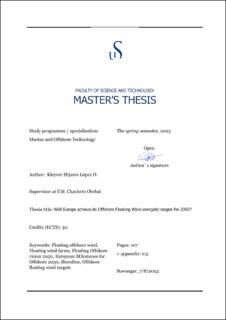| dc.description.abstract | The objective of this master's thesis is to investigate the feasibility of assembling and installing the expected capacity of offshore wind farms. The focus of the study will be solely on the installation of Offshore Floating Wind Turbines. Disregarding other factors such as grid connection, cabling installation, substation refurbishment or installation, and supply chain considerations. The study employs a modeling tool called Shoreline, to determine if offshore wind hub ports strategically situated in critical locations across Europe can meet the estimated installed capacity indicated in governmental and European association projections for the decades to come, specifically up to 2050. These hub ports are chosen based on established parameters. The assembly process involves the assemblage of the wind turbines (including the tower, nacelle, and blades) and floating substructures (such as spars or semisubmersibles) for posterior mating and hook-up with their respective anchoring and mooring line systems. The study aims to give insights into the feasibility of reaching future offshore floating wind capacity objectives, with a particular emphasis on installation issues within the chosen hub ports.
7 hub ports were assigned across Europe and progressively modified the assets involved in the installation process of the wind farms expected to be deployed in the future. At first, the most optimal installation asset combination was found for both types of hub ports (hub ports installing semi-submersible wind turbines and only Norway using spar-buoy floaters) in terms of the completion time of one single project. In the case of semi-submersible hub ports, adding an extra set of tugs and an extra floater assembly crane (two in total for both assets) turned out to be considerably beneficial for the completion of this pilot wind farm. On the other hand, for the spar-type hub port, adding two extra sets of tugs and an additional anchor handling vessel (three sets of tugs and two AHVs in total) significantly reduced the completion time of the project. Subsequently, other cases were considered since the limiting criteria for the allocation of hub ports per country is the integration crane (crane used to assemble the wind turbine to its floater). First, an ideal case where each hub port had its own integration crane was made in order to have a reference target achievement date for further comparison; this ideal case showed that most of the countries were relatively close to reaching their targets on time. Thereafter, the number of cranes was periodically reduced with the intention of showing how this will affect the total installed capacity of the hub ports and make a more realistic estimation of the total installed capacity. A sensitivity study was carried out, so as to determine non-arbitrary crane transfer criteria among the countries, giving as a result that a more equitable outcome will be obtained if the integration crane is transferred by proximity between nations and by elapsed time rather than installed wind capacity. Successively, the comparison between fully operating hub ports and interrupted ones by crane transfer operations was carried out and showed that most of the countries decrease their installed capacity by approximately 50% in most of the instances. This decrease significantly extends the target achievement date of the nations. Based on a comprehensive analysis considering all the assumptions made in this master thesis, and after the results obtained, it is strongly recommended that governments enhance their policies if they aspire to achieve their targets by 2050; in aspects such as licensing, investment in power grids, substations, and port facilities, and lastly, prioritize the development of technologies associated with integrations cranes in order to enhance the number of hub ports per country. | |
